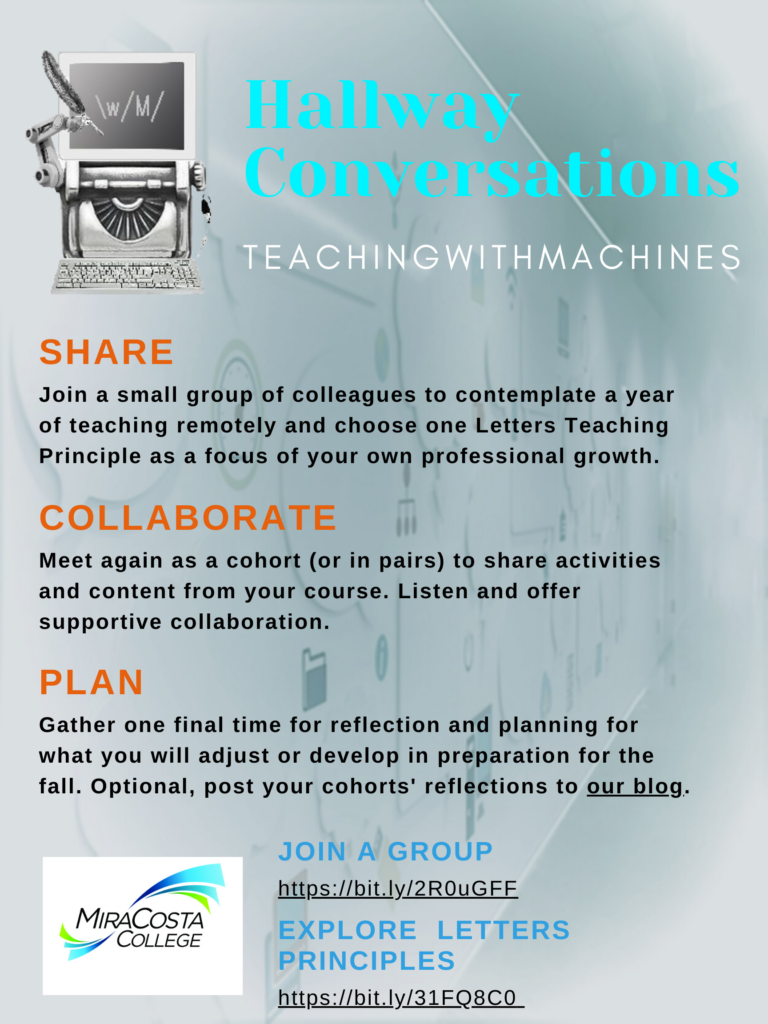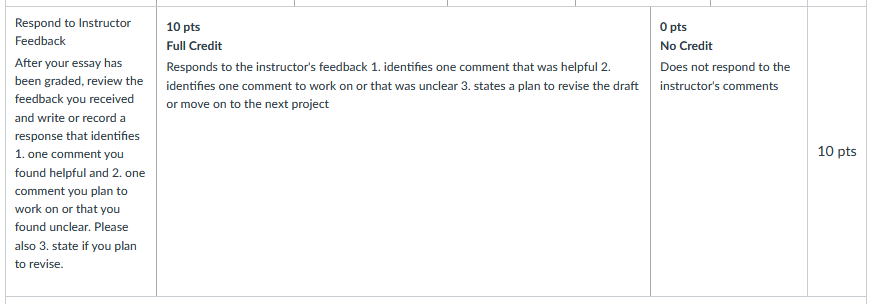
Hearing From Our Students

Hear from your students
Share the results
Embed StuffMost tools offer an embed code option with the < > symbol. If they don’t, you can use this html code to embed just about anything, even editible Google Docs! To embed the results of Google Forms, you can follow this dorkey tutorial.Curate StuffMany of us create class playlists from the content students share. Make a regular place to spotlight student generated conctent in your weekly announcements, your instructional content, and your Zoom meeting activities.
Listen, lighten, and illuminate
Incentivize Responses to Your Feedback
- Offer extra credit
- Make responses worth points
- Use the Requirements options in Modules to lock content until students post a response to your feedback
Create Ticket-out Activities (totally stole this from Chad)
- Ask “muddiest-point” questions at the end of a module
- Ask affective questions at the end of the week
- Share the results just-in-time
We’re Establishing Routines
Assignments You Value = Assignments Your Students Value
- Meeting deadlines
- Resubmitting revised work
- Visiting office hours
- Seeking Campus Resources
- Low-stakes Reading Responses/Quizes
- Discussion Posts and Replies
- Active Participation in Zoom
- Essay Drafts
- Metacognitive Reflections
Spotlight Student Work
- Shout-out students by name or by their work in your weekly announcements
- Start Zooms session with “What’s Great from Last Week”
- Integrate student generated content into your assignments and instruction
Turn Around Time
- Short responses to email with a template of links to office hours and campus resources
- Spare feedback on assignments with an invitation to reply with more questions or meet to talk
- Canvas’ Rubric that outlines basic criteria and describes opportunities to ask for clarification or even resubmit the assignment
- Canvas’ “Contact Student Who…” Grades feature that individualizes communication to groups of students
Welcoming Our Students
- Introduce yourself
- Describe your course theme or question
- Provide links to the textbook and/or important apps or software
- Screencast a brief tour of your Canvas course
- Provide a list of important Week 1 due dates
- Student Support Services and Resources
- Participation, Late Work, and Extra Credit policies
- Major assignments with a breakdown of grades
- What to expect in Zoom meetings (including accommodations for voice and video participation)
The Online Education Initiative group created asynchronous tutorials that help students prepare for online course work. Topics include “Getting Tech Ready,” “Communication Skills,” and “Online Reading Strategies.”
- Send out a brief survey
- Assign a low-stakes “syllabus” quiz
- Assign a muddiest-point discussion
The information we share to welcome and encourage our students is important, and equally (if not more) important is how our students receive and interpret that information. A quick, low-stakes assignment at the end of the first week can give you and your students an opportunity to clarify expectations, increase confidence, and even collaborate over how best to participate in your course.
Mental Health in Online Teaching
Happy end of the semester, Letters colleagues!
In my last Writing with Machines professional development workshop as your interim Technology Coordinator, we had a great discussion about supporting mental health and wellness, for both ourselves and our students, in our online classes. Please check out the Zoom recording and Google slideshow below to hear your colleagues’ great ideas about how to support student mental health through pedagogy and practice, as well as how anti-racist work promotes mental wellness. You are also invited to to add comments and share your own ideas on mental health and wellness online.
Thank you for your time, participation, and support this semester! Have a restful, safe, and healthy winter break. See you in the spring!
https://docs.google.com/presentation/d/1dXRU1oZcdwCzzP-bOSqnpIgRgqP5fnFw28pOkwbhcKY/edit?usp=sharing
Anti-Racist Labor-Based Grading and Feedback
Do the terms “anti-racist” and “labor-based grading” make you a little nervous? Not to worry! Our most recent Writing with Machines professional development workshop spotlights pragmatic and successful implementations of both praxes. Check out my Google slideshow as well as the Zoom recording with your fabulous colleagues! Feel free to respond with your thoughts and/or examples of effective grading and feedback practices.
Culturally Sustaining Feedback and Equitable Grading
Hello, Letters family!
If you missed the Writing with Machines professional development workshop on culturally sustaining and equitable feedback and grading of student work, check out the following Google slideshow with embedded readings, videos, and other resources, as well as the recording of the Zoom session. Add your own ideas and questions to the comments!
Whiteboards, Huddleboards, and Gallery Walks in Online Classes
Some of my favorite in-class teaching tools are now gone as we head into an online fall semester….or so I thought! I use the whiteboards, huddleboards, large sticky notes, and computer screens all the time when I teach. We’re constantly in groups working on something that we want to display for others to see or spreading out around the whiteboards in the room to make notes about characters in a novel. I’ve also become very accustomed to using the whiteboard in the class as a place to make quick notes, demonstrate concepts, or validate student responses by writing them down. Now that we’re online, these physical, tangible tools need to be replaced somehow. The two best ways that I’ve found so far are the Padlet app and Zoom annotations.
Here are links to two of the Padlets I referenced in the video if you’d like to see more:
Criminal Justice Reform Padlet
Check out the video below to see a few examples of how I use these tools:
Sawubona (I See You) – Decolonizing Research Methods and Practices
Inspired by the Zulu greeting, Sawubona (I see you), and this week’s Black Lives Matter Training by awesome professors Bruce Hoskins, Shawntae Mitchum, and Edwina Williams, I have been reflecting on what I’ve done and what more I can do to make research projects more inclusive of diverse epistemologies, voices, and histories. Check out my video for more, and please let me know if you have recommendations or want to share any of your research practices, especially in online classes. Thanks!
